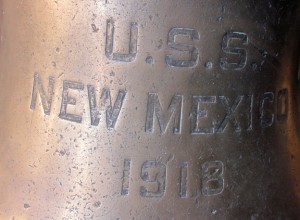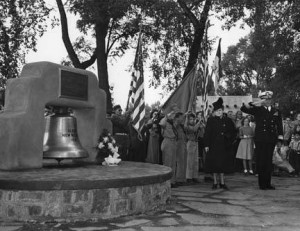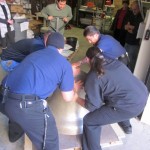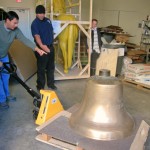 By the time the USS New Mexico battleship was decommissioned in 1946, her bells had rung out alarms of attacks and tolled the grief felt by those who survived as they buried at sea the shipmates who had given their lives. The “Queen of the Fleet,” commissioned in 1918 and christened with both champagne and the waters of the Rio Grande, had served as the finest battleship of the Pacific fleet and endured attacks by kamikazes and bombers. For her World War II service, the ship received six battle stars and is still recalled with awe — even though she was sold for scrap in 1947.
By the time the USS New Mexico battleship was decommissioned in 1946, her bells had rung out alarms of attacks and tolled the grief felt by those who survived as they buried at sea the shipmates who had given their lives. The “Queen of the Fleet,” commissioned in 1918 and christened with both champagne and the waters of the Rio Grande, had served as the finest battleship of the Pacific fleet and endured attacks by kamikazes and bombers. For her World War II service, the ship received six battle stars and is still recalled with awe — even though she was sold for scrap in 1947.
The story might have ended there but for those bells — one of which arrived on Friday, Nov. 16, at the New Mexico History Museum after a circuitous post-war life. That part of the story goes back to New Mexico Gov. Thomas Mabry, who began working in 1947 on obtaining one of the ship’s two bells.
His correspondence with Secretary of the Navy John L. Sullivan reflects the state’s desire to spare the bell from the scrapyard. Sullivan shared the goal, but it was a weighty one — 1,100 pounds, according to a Dec. 22, 1947, letter from the Navy chief.
“It was the practice of the Navy to outfit some of the older battleships with two bells, and the U.S.S. NEW MEXICO was so equipped,” he wrote. “It would give me much pleasure to donate the bell of the U.S.S. NEW MEXICO to you on behalf of the State of New Mexico, but before doing so, there are two conditions which must be fulfilled. The first is that Congress must approve all donations. … The second condition is that the State of New Mexico must agree to defray all expenses incidental to packing and shipping.”
Our correspondence file includes Mabry’s request to obtain the portion of the ship’s bulkhead that held a painted record of how many Japanese planes and shore installations were destroyed by the ship’s guns. If the letters are correct, the bulkhead made it to New Mexico, but we’ve been unable to trace where it went. We do, however, know what happened to the bell.
In 1948, Gov. Mabry and Mayor Frank Ortiz officiated at a dedication ceremony as the bell was placed on the Santa Fe Plaza. (The photo above was taken at the event by Robert H. Martin. Palace of the Governors Photo Archives 41320.) It stood on the Plaza for nearly 30 years. An early 1970s Plaza renovation forced its removal, but the Manuel Lujan Sr. building in the state’s South Capitol Complex gladly took possession of it. It hung below a stairway near the building’s vending-machine area until a recent renovation there forced yet another move.
This time, we were ready. We have the storage space, we have a small exhibition dedicated to the battleship and its nuclear-submarine namesake, and we have staffers who feel an emotional tie to the ship and its mates.
“It represents to much,” said Tom Leech, director of the Palace Press and curator of our lobby-area exhibit, A Noble Legacy: The USS New Mexico. “When I think about what that bell has been through — it’s rung general alarms when the ship was under attack. It rang when those guys were buried at sea.”
(To learn more about the ship’s ordeals and heroism, check out this mini-documentary, USS New Mexico BB40: The Drinan Diary, produced by the museum and Michael Kamins of KNME-TV in Albuquerque.)
Getting the bell delivered to our loading dock was one thing. Figuring out how to get it to our lower-level almost-hermetically-sealed collections vault was another.
First, staff members eyeballed it. Warily.
Then, four of our burliest guys tried to move it …
… but couldn’t even budge it.
Finally, we resorted to good old hydraulics.
As for what happened to the second bell, we know that the University of New Mexico acquired it, possibly with the help of the Alpha Phi Omega fraternity, but we aren’t certain where it is. Outside the Student Union Building? At the football stadium? Inside the ROTC building? If you know, drop us a line. (And if you know what happened to its clapper, which our records showed “disappeared, mysteriously, during the early 1970s,” we’d be interested in that as well.)
Our hope is to put our bell on display as soon as we polish off some other priorities. One popular suggestion is to place it in the Palace Courtyard. We’ll let you know when that happens. In the meantime, we’re pleased and proud that an important part of New Mexico’s heritage is sharing quarters with so many other artifacts that tell the stories of who we are.




